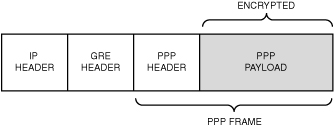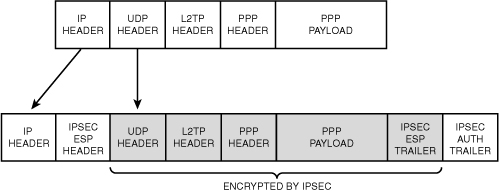PPTP,
L2TP, and SSTP are the communication standards used to manage tunnels
and encapsulate private data. It is important to note that data
traveling through a tunnel must also be encrypted to be a VPN
connection. Windows Server 2008 R2 includes PPTP, L2TP, and SSTP
tunneling protocols.
To establish a tunnel, both
the tunnel client and tunnel server must be using the same tunneling
protocol. Tunneling technology can be based on either a Layer 2 or Layer
3 tunneling protocol that corresponds to the Open System
Interconnection (OSI) reference model. Layer 2 protocols correspond to
the Data-link layer and use frames as their unit of exchange. PPTP and
L2TP are Layer 2 tunneling protocols that encapsulate the payload in a
PPP frame before it is sent across the Internet. Layer 3 protocols
correspond to the Network layer and use packets. IPSec tunnel mode is a
Layer 3 tunneling protocol that encapsulates IP packets in an additional
IP header before sending them across the Internet.
Windows 7, Windows Vista,
Windows XP, and Windows 2000 workstation VPN client and server computers
support both L2TP/IPSec and PPTP by default. Both PPTP and L2TP/IPSec
use PPP to provide an initial envelope for the data and then append
additional headers for transport through the Internet. PPTP and L2TP
also provide a logical transport mechanism to send PPP payloads and
provide tunneling or encapsulation so that PPP payloads based on any
protocol can be sent across the Internet. PPTP and L2TP rely on the PPP
connection process to perform user authentication and protocol
configuration.
There are a few
differences between the three protocols. First, when using PPTP, the
data encryption begins after the PPP connection process is completed,
which means PPP authentication is used. With L2TP/IPSec, data encryption
begins before the PPP connection process by negotiating an IPSec
security association. In SSTP, the session is encrypted by SSL before
authentication begins. In DirectAccess, communications are encrypted
transparently before user data begins to flow.
Second, PPTP connections
use MPPE, a stream cipher that is based on the Rivest-Shamir-Adleman
(RSA) RC-4 encryption algorithm and uses 40-, 56-, or 128-bit encryption
keys. Stream ciphers encrypt data as a bit stream. L2TP/IPSec
connections use the Data Encryption Standard (DES), which is a block
cipher that uses either a 56-bit key for DES or three 56-bit keys for
3DES. Block ciphers encrypt data in discrete blocks (64-bit blocks, in
the case of DES). SSTP uses SSL with RC4 or AES. DirectAccess uses 3DES
or AES.
Finally, PPTP
connections require only user-level authentication through a PPP-based
authentication protocol. L2TP/IPSec connections require the same
user-level authentication as well as computer-level authentication using
computer certificates. In contrast, SSTP and DirectAccess only require
computer-level certificates for the VPN servers.
Table 1 compares some of the characteristics of the three tunneling protocols.
Table 1. Comparing VPN Protocols
| Characteristics | PPTP | L2TP/IPSec | SSTP |
|---|
| Encapsulation | GRE | L2TP over UDP | SSTP over TCP |
| Encryption | Microsoft Point-to-Point Encryption (MPPE) with RC4 | IPSec ESP with Triple Data Encryption Standard (3DES) or Advanced Encryption Standard (AES) | SSL with RC4 or AES |
| Tunnel maintenance protocol | PPTP | L2TP | SSTP |
| When user authentication occurs | Before encryption begins | After the IPSec session is established | After the SSL session is established |
| Certificates needed | None | Computer certificates on both the VPN client and VPN server | Computer certificate on the VPN server and root CA certificate on the VPN client |
| Client | Windows 9x and above | Windows 2000 and above | Windows Server 2008, Windows XP SP3, and Windows Vista SP1 |
Tunneling Within a Windows Server 2008 R2 Networking Environment
For
Layer 2 tunneling technologies, such as PPTP, L2TP, and SSTP, a tunnel
is similar to a session; both of the tunnel endpoints must agree to the
tunnel and must negotiate configuration variables, such as address
assignment or encryption or compression parameters. In most cases, data
transferred across the tunnel is sent using a datagram-based protocol. A
tunnel maintenance protocol is used as the mechanism to manage the
tunnel.
Layer 3 tunneling
technologies generally assume that all the configuration settings are
preconfigured, often by manual processes. For these protocols, there
might be no tunnel maintenance phase. For Layer 2 protocols (PPTP, L2TP,
and SSTP), however, a tunnel must be created, maintained, and then
terminated.
After the tunnel is
established, tunneled data can be sent. The tunnel client or server uses
a tunnel data transfer protocol to prepare the data for transfer. For
example, as illustrated in Figure 1,
when the tunnel client sends a payload to the tunnel server, the tunnel
client first appends a tunnel data transfer protocol header to the
payload. The client then sends the resulting encapsulated payload across
the internetwork, which routes it to the tunnel server. The tunnel
server accepts the packets, removes the tunnel data transfer protocol
header, and forwards the payload to the target network. Information sent
between the tunnel server and tunnel client behaves similarly.

Point-to-Point Tunneling Protocol
The Point-to-Point
Tunneling Protocol (PPTP) is a Layer 2 protocol that encapsulates PPP
frames in IP datagrams for transmission over the Internet. PPTP can be
used for remote access and router-to-router VPN connections. It uses a
TCP connection for tunnel maintenance and a modified version of Generic
Routing Encapsulation (GRE) to encapsulate PPP frames for tunneled data.
The payloads of the encapsulated PPP frames can be encrypted and/or
compressed. Figure 2 shows the structure of a PPTP packet containing user data.

Layer 2 Tunneling Protocol
Layer 2 Tunneling Protocol
(L2TP) is a combination of the Point-to-Point Tunneling Protocol (PPTP)
and Layer 2 Forwarding (L2F), a technology proposed by Cisco Systems,
Inc. L2TP encapsulates PPP frames that are sent over IP, X.25, frame
relay, and ATM networks. The payloads of encapsulated PPP frames can be
encrypted and/or compressed. When sent over the Internet, L2TP frames
are encapsulated as User Datagram Protocol (UDP) messages, as shown in Figure 3.

L2TP
frames include L2TP connection maintenance messages and tunneled data.
L2TP connection maintenance messages include only the L2TP header. L2TP
tunneled data includes a PPP header and PPP payload. The PPP payload can
be encrypted or compressed (or both) using standard PPP encryption and
compression methods.
In Windows Server 2008
R2, L2TP connections do not negotiate the use of PPP encryption through
Microsoft Point-to-Point Encryption (MPPE). Instead, encryption is
provided through the use of the IP Security (IPSec) Encapsulating
Security Payload (ESP) header and trailer.
IP Security
IP Security (IPSec) was designed
as an end-to-end mechanism for ensuring data security in IP-based
communications. Illustrated in Figure 4,
the IPSec architecture includes an authentication header to verify data
integrity and an encapsulation security payload for both data integrity
and data encryption. IPSec provides two important functions that ensure
confidentiality: data encryption and data integrity. IPSec uses an
authentication header (AH) to provide source authentication and
integrity without encryption and the Encapsulating Security Payload
(ESP) to provide authentication and integrity along with encryption.
With IPSec, only the sender and recipient know the security key. If the
authentication data is valid, the recipient knows that the communication
came from the sender and that it was not changed in transit.

Note
IPSec also plays a key role in another remote access technology, the new Windows Server 2008 R2 DirectAccess.
Secure Socket Tunneling Protocol
Introduced
in Windows Server 2008, SSTP was specifically developed to get around
the difficulties of setting up VPN tunnels through corporate firewalls,
which block many of the ports and protocols used by PPTP and L2TP. The
SSTP tunnel uses the HTTP over SSL (HTTPS) protocol, which is widely
supported for secure web traffic. SSTP uses port 443 for the connection.
The tunneling protocol
functions by encapsulating the original IP packet with a PPP header and
then an SSTP header. The SSTP header, the PPP header, and the original
IP packet are all encrypted by the SSL session. Finally, an IP header is
added to the packet and it is routed to the destination. The structure
of the packet is shown in Figure 5.

Note
Interestingly, even though
SSTP is based on the HTTPS web protocol, the VPN server does not have to
be configured with IIS. The RRAS VPN server listens for SSTP
connections on the uniform resource identifier (URI)
/sra_{BA195980-CD49-458b-9E23-C84EE0ADCD75}/. This does not conflict
with or require IIS, so IIS can be installed if needed for other
purposes.
Unfortunately, SSTP does not
support tunneling through web proxies that require authentication.
Another limitation of SSTP is that it does not support site-to-site
connections in Windows Server 2008 R2, which both PPTP and L2TP do.